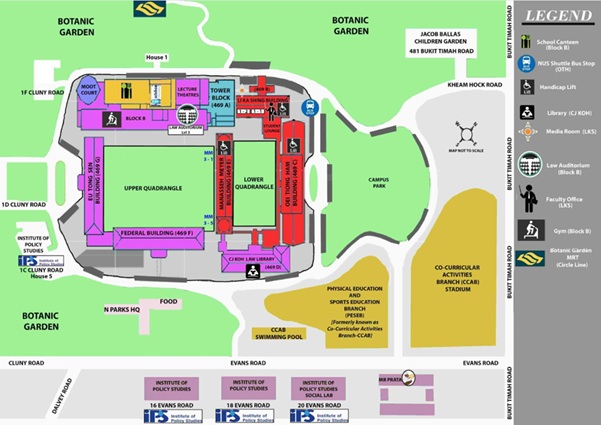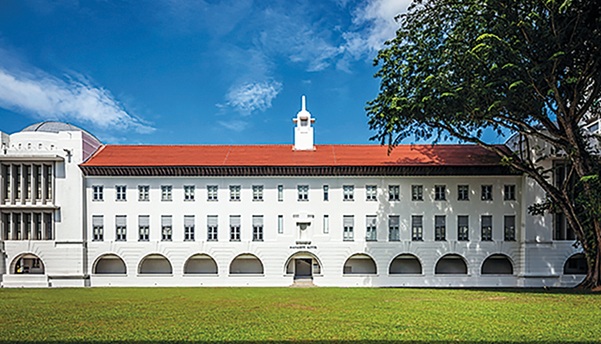VENUE
ASIA COMPETITIVENESS INSTITUTE
Lee Kuan Yew School of Public Policy – National University of Singapore
469C, Bukit Timah Road, Singapore 259772
About Lee Kuan Yew School of Public Policy
The Lee Kuan Yew School of Public Policy (LKYSPP), which is part the National University of Singapore, was established in 2004 with the mission of educating and training the next generation of Asian policymakers and leaders.
Our strategic location in Singapore – a city-state widely known for its strong governance and efficient civil service – enables students to study in one of the best public policy laboratories in the world, while accessing the wider Asia-Pacific region in a distinctively global environment.
Situated beside the world-famous Singapore Botanic Gardens, a newly crowned UNESCO World Heritage site, the conference venue is spread over sloping lawns and grassy quadrangles, interspersed with pristine white colonial-era architecture in the neo-classical style. These white buildings serve as home to think-tanks and generate strategic research on contemporary issues, from international law to Asian regional developments, from social policies to economic growth and water management.

Find out more about Lee Kuan Yew School of Public Policy here.
About Asia Competitiveness Institute
The Asia Competitiveness Institute (ACI) was established in August 2006 as a research centre at the Lee Kuan Yew School of Public Policy (LKYSPP), National University of Singapore (NUS). It aims to build intellectual leadership and network for understanding and developing competitiveness and sustainable growth in Asia. ACI seeks to contribute to the enhancement of inclusive growth, living standards, and institutional governance through competitiveness research on sub-national economies in Asia. It identifies mitigating issues and challenges for potential public policy interventions through close collaboration with regional governments, business corporations, policy think tanks, and academics. ACI’s three key research pillars include (i) sub-national economies level competitiveness analysis, (ii) emerging sustainable development landscape in 16 Asia economies, and (iii) Asia’s long-term growth strategies and public policy analysis.
ACI’s value proposition may be encapsulated in its acronym:
Analytical inputs to initiate policies for policy-makers and business leaders in Asia
Capacity building to enable others through improvement in productivity and efficiency
Intellectual leadership to create pragmatic models of competitiveness and inclusive growth
The institute’s core research competencies can also be encapsulated in this acronym describing our evidence-based assessments conducted on public policies for ASEAN in the context of the rise of China and India.
The Institute works in affiliation with Professor Michael E. Porter’s Institute for Strategy and Competitiveness (ISC) at the Harvard Business School. Professor Porter is also the Chairman of the Institute’s International Advisory Panel.
ACI is funded by Singapore’s Ministry of Trade and Industry, which oversees the Institute’s key performance indicators as a condition for funding. ACI also seeks out additional research funding for individual research projects.
Find out more about Asia Competitiveness Institute here.
About Manasseh Meyer Building

In 1918, the British colonial administration proposed the establishment of a college to mark the centenary of Singapore’s founding by Sir Stamford Raffles. The idea was supported by local communities, and notably by individuals such as Oei Tiong Ham, Manasseh Meyer and Eu Tong Sen — prominent businessmen and philanthropists of the day — who made large donations. A decade later, on land formerly part of the Singapore Botanic Gardens, Raffles College commenced operations as the first institution for tertiary education in the arts and sciences in British Malaya.
As the years passed and student numbers increased, the campus was steadily expanded to cater to their growing needs. More buildings were constructed between the 1940s and 1960s, including a new wing simply named Block A, a Library Building, a geometric-style Block B and a 10-storey Science Tower. It was also around this time that Raffles College was upgraded to university status and underwent a couple of name changes, to the University of Malaya in 1949 and then the University of Singapore in 1962.